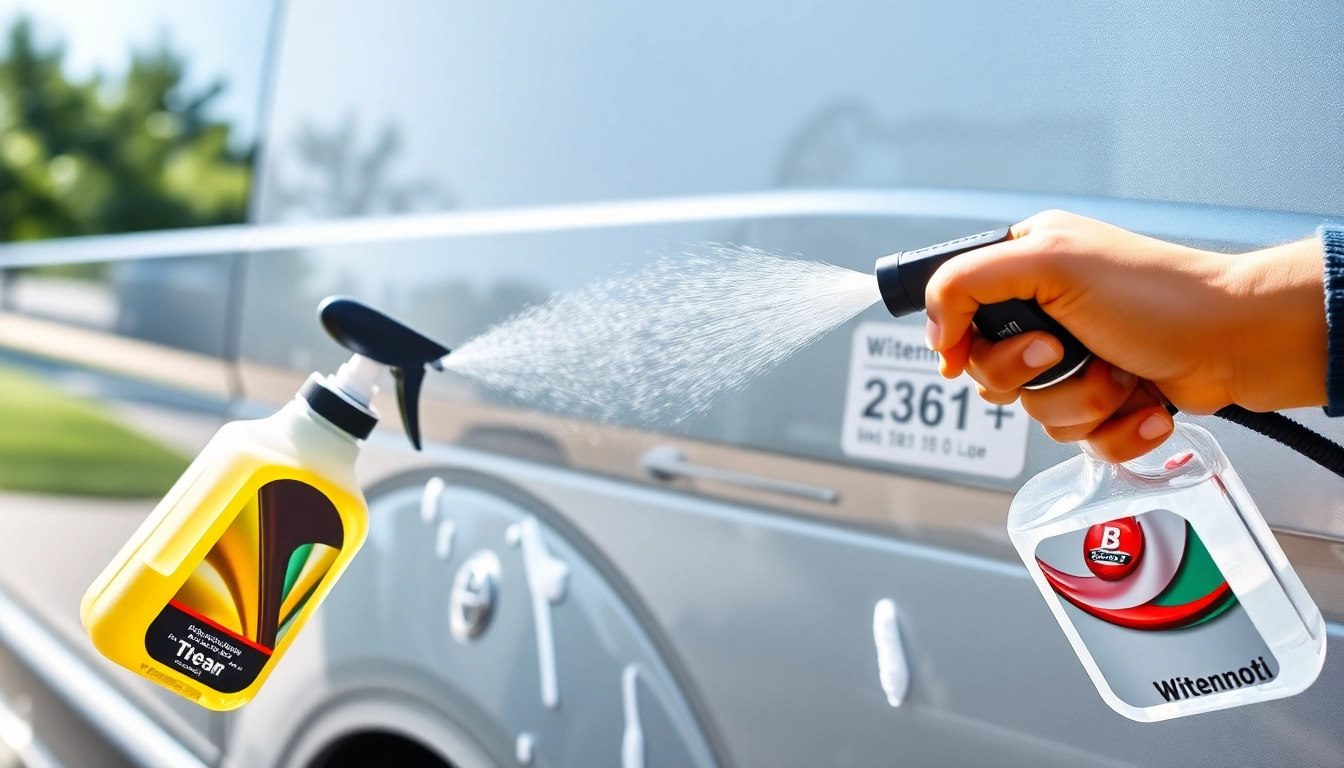Fundamentals of Recreational Vehicle Cleaning with Wohnmobilreiniger
Maintaining a pristine appearance and prolonging the lifespan of your camper van or motorhome requires the right cleaning tools and techniques. Among the core essentials is the Wohnmobilreiniger, a specialized cleaner designed specifically for the unique surfaces and materials found on motorhomes and campers. A high-quality Wohnmobilreiniger ensures effective removal of dirt, grime, and environmental residues such as insects, bird droppings, and salt deposits, all while protecting the vehicle’s coatings and surfaces. To achieve optimal results, it’s crucial to understand what constitutes a good camper cleaner, the key ingredients involved, and the proper application procedures.
What Defines a Good Wohnmobilreiniger?
The ideal Wohnmobilreiniger stands out through several characteristics that guarantee efficient cleaning without damaging the vehicle. First, it must have strong, yet gentle cleaning power suited to various surfaces like gelcoat, plastics, aluminum trims, and painted finishes. It also needs to be environmentally friendly, biodegradable, and free from aggressive chemicals that could harm seals, rubber components, or the vehicle’s surroundings. User-friendliness is equally important—a good cleaner should be easy to apply, requiring minimal effort and time, and should produce visible results effortlessly.
Furthermore, a high-quality Wohnmobilreiniger is versatile enough to be used on multiple surfaces, from the exterior panels to the windows and even to the interior if specified. It should also be compatible with additional maintenance products such as sealants and polishes, allowing for a comprehensive care routine.
Key Ingredients and Their Effects
The effectiveness and safety of a Wohnmobilreiniger hinge greatly on its formulation. Common effective ingredients include biodegradable surfactants, gentle acids or alkalis for stubborn dirt, and cleaning agents that target specific contaminants such as oil, grease, or mineral deposits. For example, surfactants facilitate the emulsification of dirt, enabling its easy removal, while mild acids like citric acid are effective against mineral stains and water spots.
Crucially, modern Wohnmobilreiniger formulations prioritize environment-friendly components to minimize ecological impact, aligning with sustainable camping and vehicle maintenance practices. Manufacturers often include additional additives, such as corrosion inhibitors, UV protectants, or lubricants, to preserve surface integrity and prevent damage during cleaning.
Suitable Cleaning Agents for Various Surfaces
Different surfaces on your vehicle require tailored cleaning solutions to prevent damage and ensure thorough cleanliness. For painted panels and gelcoats, mild, pH-neutral cleaners are recommended to avoid stripping protective coatings. Plastic trims and windows often benefit from specific glass and plastic cleaners that do not leave streaks or residues.
Aluminum or metal fixtures need cleaners that prevent corrosion, while rubber seals should be treated with gentle, non-abrasive products. For interior surfaces, such as upholstery or plastics, mild detergents combined with microfiber cloths work best. Always check the manufacturer’s guidelines for each surface type and choose a cleaner specifically formulated for that purpose to maintain the vehicle’s aesthetic and structural integrity.
Step-by-Step Guide: Effective Cleaning of Your Camper Van or Motorhome
Preparation and Protective Measures
Begin by gathering all necessary cleaning tools, including microfiber towels, soft sponges, brushes, and specific cleaning agents. Protect sensitive areas by covering vents, electrical components, and seals with appropriate coverings or masking tape. Ensure the vehicle is cool and shaded to prevent rapid drying or streaking of cleaning products. Personal protective equipment, such as gloves and eye protection, should also be used to safeguard skin and eyes from chemical exposure.
Proper Application of Wohnmobilreiniger
Start with the exterior, applying the Wohnmobilreiniger using a foam gun or spray bottle, ensuring an even coat over all surfaces. For larger vehicles, a foam cannon like the Snow Foam Gun simplifies the process, allowing thick foam to cling to surfaces and loosen dirt effectively. Let the foam sit for a few minutes but do not let it dry out. Use soft brushes or microfiber wash mitts to gently scrub surfaces, paying attention to stubborn spots. Rinse thoroughly with clean water, preferably using a pressure washer at low to medium pressure, avoiding high pressure directly on seals or delicate parts.
For intricate areas such as corners or around fixtures, detailed brushes can help reach into crevices without scratching surfaces. Dry the vehicle with a microfiber towel like the BCC Drying Towel to prevent water spots and streaks, ensuring a smooth, glossy finish.
Post-Cleaning Maintenance: Sealants and Polishes
After cleaning, applying a high-quality sealant like the Power Sealer helps protect the surface from environmental damage, UV rays, and dirt accumulation. For areas with scratches or oxidation, polishing compounds such as the Power Polish can restore a glossy, like-new appearance. Regular maintenance prolongs the pristine look of your vehicle and reduces the frequency and intensity of deep cleans.
Tips for Maintenance and Preservation of Your Vehicle’s Value
Regular Cleaning Intervals and Best Practices
For optimal longevity, cleaning your camper or motorhome at least once every three to four months is advisable, especially in regions with harsh environmental conditions like salt or heavy pollution. After every wash, inspect seals and joints for wear or damage, and reapply protective coatings as needed.
Common Mistakes and How to Avoid Them
One frequent mistake is using harsh household cleaners that can damage paints and seals. Instead, always opt for specialized products like the Wohnmobilreiniger. Additionally, avoid washing under direct sunlight to prevent rapid drying that causes streaks. Using inappropriate tools, like steel brushes or abrasive pads, can scratch surfaces; replace them with soft microfiber cloths and brushes designed for vehicle care.
Long-Term Strategies for a Shining, Protected Exterior
Implement a comprehensive maintenance routine that includes regular washes, waxing, and protective sealants. Using products like the Power Sealer lends a hydrophobic layer that repels dirt and water, simplifying future cleaning efforts and maintaining glossiness over time. Avoid neglecting subtle areas—regularly clean around fixtures, windows, and rubber seals to prevent deterioration.
Comparative Analysis and Selection of the Best Wohnmobilreiniger
Top Products Based on Tests and Reviews
Effective Wohnmobilreiniger products are evaluated on cleaning power, surface compatibility, environmental impact, and ease of use. Leading brands such as those available on platforms like Amazon or specialized retailers like Fritz Berger offer a range of options, including waterless cleaners, foam-based products, and all-in-one maintenance kits. For instance, cleaners like the cleanofant Wohnmobil-Reiniger have gained high ratings for their versatility and eco-friendly formulas. Testing indicates that foaming cleaners combined with microfiber towels produce superior results, reducing scratches and streaks.
Differences Between Classic and Waterless Cleaners
Traditional cleaners often require extensive water usage, while innovative waterless or rinseless products are designed for quick, eco-conscious cleaning without water. Waterless options are ideal for outdoor setups or in areas where water access is limited. They typically contain special agents that encapsulate dirt, making wiping safe and effective. Choosing between these types depends on your cleaning environment, vehicle condition, and personal preferences.
Recommendations for Specific Surfaces and Materials
Use mild, pH-neutral products for painted surfaces and gelcoats, while dedicated plastic or glass cleaners are best suited for windows and panels. Sealants and polishes should be applied following cleaning to enhance gloss and protection, especially after aggressive washes or repairs. Always ensure compatibility of products with your particular material, and consider consulting manufacturer specifications or expert advice for specialized surfaces.
Frequently Asked Questions (FAQ) Regarding Wohnmobilreinigung
Which Type of Cleaner Is Suitable for My Camper Van?
For general exterior cleaning, a versatile Wohnmobilreiniger like the Power Cleaner is recommended. For sensitive surfaces and detailed work, specialized products such as plastic or glass cleaners, or waterless cleaners, may be more appropriate. Always check product labels for surface compatibility to avoid damage.
How Can I Prevent Scratches and Surface Damage?
Using soft microfiber cloths and brushes specifically designed for vehicle care is essential. Avoid abrasive tools like steel wool or rough scrub sponges. Employing foam cleaning methods and maintaining a frequent wash routine reduces the buildup of stubborn dirt that can cause scratches during cleaning.
How Frequently Should I Wash My Camper or Motorhome?
Optimal cleaning intervals depend on environmental exposure. Typically, every three to four months is sufficient; however, in coastal or heavily polluted areas, more frequent washes are advisable. Regular maintenance after each trip ensures removing abrasive residues that could accelerate deterioration.



